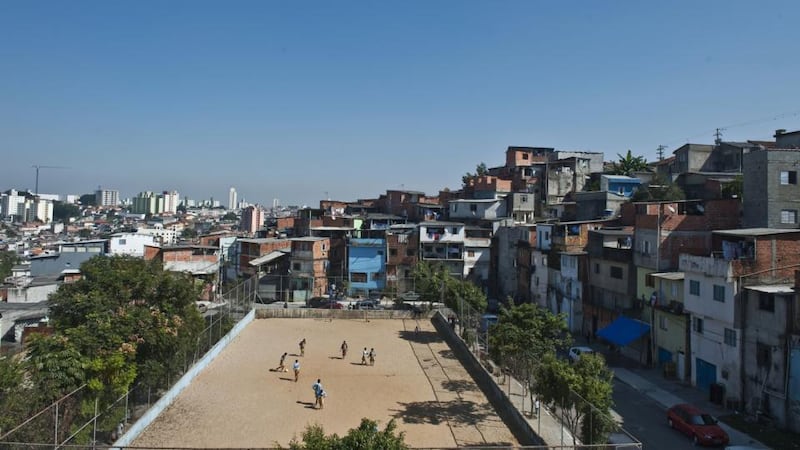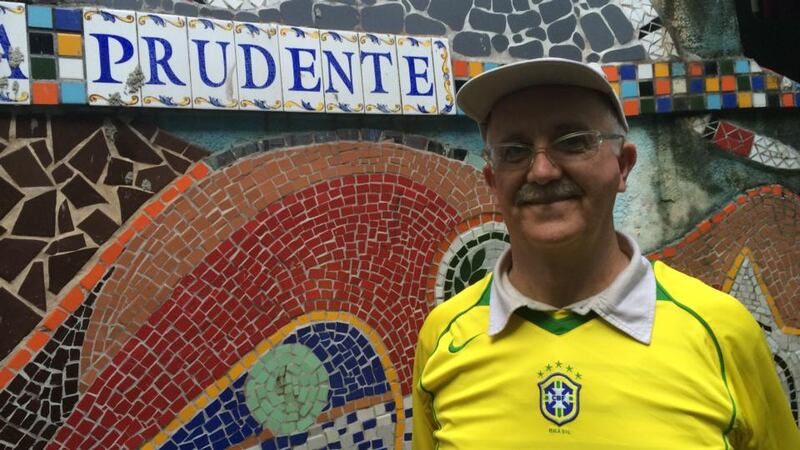A poodle wears a yellow-and-green collar exactly like a tennis player’s wristband, and its friendly owner smiles hello. There is a hot sun in a blazing blue midwinter sky, and little groups of fans are converging on what today is the resplendent boulevard of Avenida Paulista.
It's a public holiday and even the city's notorious traffic has disappeared. As helicopter blades cut through the air, downtown São Paulo feels like the centre of the universe.
Now, go underground, get on Line 2 heading east, and count the metro stops: 1 . . . 2 . . . 3 . . . 4 . . . 5. . . 6 . . .7. . .8. Come up the steps at Vila Prudente. This is where we begin.


Andre Delfino Da Silva, a community leader and advocate in the Vila Prudente favela, waits at the top of the steps.
He is wearing a faded Corinthians jersey – a rare sight when the Seleçao play – and has broad shoulders and a quiet physical power that appear to symbolise his position in local public consciousness.
We look across the road at the brutalist concrete stilts of the unfinished sky rail, which halts with menacing suddenness just a couple of hundred metres from the favela through which it may soon plough.
Vincent Deely's car pulls up. "Sorry, I'm late!" We hop in the back. Deely is a Galway man who has lived in Brazil for 28 years, working on development issues in São Paulo's favelas, mostly with Irish religious orders.
No 9 shirt
Today he is wearing a Brazil No 9 jersey, with “Vincent” on the back. Why not No 10? “It’s Ronaldo’s from 2002.” He is plainly proud the jersey still fits.
Deely, a layman with a Brazilian wife and two children, looks like a more genial, Irish version of Luiz Felipe Scolari; not unlike the softer Scolari who appears in cheesy ads on Brazilian television.
He is a passionate sports fan and above all a lover of hurling. His guiding principle when watching matches, as will be clear when Brazil play Croatia, is to support the team that is less fancied.
We pull up near the rubbish outside Favela Jacaraipe. The first of an entire day of barbecued meat aromas washes over us.
Middle-aged Ze Carlos, wearing a heavy coat and a baseball cap, comes out to greet and guide us down the narrow tunnels Deely compares to the catacombs in Rome. We would not be able to come here unaccompanied, especially after dark, when drug dealers have the run of the place.
Of course it is already nearly dark, a warren of underground life. Hades. Curious, scampering kids in Brazil colours, faces of adults peering from grim shutters.
With the sun shining, and people in World Cup mood, it is a sobering thought that Jacaraipe probably looks at its best right now.
Now and then a desolate, drug-ruined face floats by like a wraith. In what appears the blackest of jokes, a few of the tiny doorways have signs to say the property is for sale.
In Favela Jacaraipe, 700 families are shoehorned into 35,000 square metres. How can they find more room to live as people should?
The good news is the gleaming Vila Prudente metro station, which opened in 2010, has raised land values in the area. The bad news is the gleaming Vila Prudente metro station has raised land values in the area. Nobody wants to sell land here any more and efforts to negotiate more living space have so far come to naught.
Today is a day for escapism: football, barbecue and community. We move to Vila Prudente, a 60-year-old favela up the road, with 8,000 residents.
It is surrounded by so many high-tension electricity pylons they look like an avant-garde architectural feature. How do you like your favelas? One lump or two?
If you want the colour and the cheer you have come to the right place. In these streets you would not be surprised if bunting was sold in measurements of 1km or more. It is sensually explosive. Every building seems to blast out some version of Brazilian favela funk.
‘I’m Lionel’
A handsome young chap comes over and introduces himself in startlingly good English (“One of the 3 per cent,” Vincent notes). He has been working on cruise ships for three years, travelling the globe.
"I'm Lionel," he says. "Like Lionel Richie". Not Lionel Messi.
The entire surface of one long, narrow street is painted in the national colours: thick stripe after thick stripe. We stop at a cool painting on a wall of the tournament mascot signed by the very un-Brazilian “Keven”. A woman sees us: “Keven! Keven!” She runs to fetch her son until he stands before us and bashfully receives our smiles and our light praise.
Andre, who works for Movimento de Defensa do Favelada - or MDF, rightly wants to show us important stuff. We walk a couple of streets and are quickly outside the party.
Rubbish piled by the railway line. A man crumpled on a mattress – is he definitely alive? – beside it. The area once destroyed by fire, the place often flooded when the river overflows.
An environment so tenuous and so hostile it is a wonder anyone can persevere with it.
Andre, a skilled negotiator, understands more than anyone the political dimension of every decision around here that determines whether people live or die, and if they do live, how they will live.
He brings us to places of pride. The church, said to contain a relic of John XXIII (“Not a bad pope to have a piece of,” Vincent remarks dryly).
Above is the cultural centre, opened in 1990 by Fr Pat Clarke, an Irish Holy Ghost father. In these remarkable buildings 60 children learn to paint, read and otherwise engage in creative practices.
This year the centre lost its funding from the Irish aid agency Misean Cara, says Deely. In Dublin it would be a haven. Here? He shows us a row of pencil sketches the kids did of one another after being taught by a visiting Irish artist, Brian Maguire. They are very good.
We rush to take up positions back at the bar near where we met Lionel. A few lads are wild-eyed and drunk. Smells of Red Bull and popcorn. Incessant horns.
One of the two barmen is wearing a Croatian jersey, having bet three drinks they will be first to score.
Next to the main TV, an old man leans out on his half-door just listening to the commentary. In the flat above a woman looks on sourly.
A supporter in a Brazil wig stands so close to the set that during a close-up of Neymar she pats him on the face. Dozens of kids squeeze through the smallest of gaps. You know how it goes: when Croatia score the people are sad; when Brazil score they are happy. In the favelas it is no different.
At full-time the bar pumps out forró, the genre from northeastern Brazil, where most favela dwellers originated. The party will go on. Across the way a man in a cowboy hat in Brazil colours peeks out from the opening in his wooden shutters, waving two little Brazilian flags. What he is saying is: goodbye.









